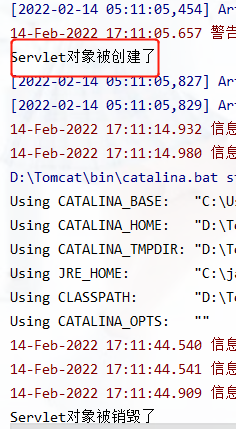目录
jsp中的out输出和response.getWriter输出的区别
ServletContextListener监听器监听ServletContext对象的步骤
jsp九大内置对象
jsp九大内置对象,是指Tomcat在翻译jsp页面成为Servlet源代码后,内部提供的九大对象,叫内置对象。

request 请求对象
response 响应对象
pageContext jsp的上下文对象
session 会话对象
application ServletContext对象
config ServletConfig对象
exception 异常对象
out jsp输出流对象
jsp四大域对象
域对象是可以向Map一样存取数据的对象。四个域对象功能一样,他们对数据的存取范围不同
四个域对象分别是:
| 域对象 | 所属类 | 访问范围 |
| pageContext | (PageContextImpl类) | 当前jsp页面范围内有效 |
| request | (HttpServletRequest类) | 一次请求内有效 |
| session | (HttpSession类) | 一个会话范围内有效(打开浏览器访问服务器,直到关闭浏览器) |
| application | (ServletContext类) | 整个web工程范围内都有效(只要web工程不停止,数据都在) |
//往四个域都分别保存了数据
<%
pageContext.setAttribute("key","pageContext");
request.setAttribute("key","request");
session.setAttribute("key","session");
application.setAttribute("key","application");
%>
pageContext域是否有值:<%=pageContext.getAttribute("key")%> <br>
request域是否有值:<%=pageContext.getAttribute("key")%> <br>
session域是否有值:<%=session.getAttribute("key")%> <br>
application域是否有值:<%=application.getAttribute("key")%> <br>
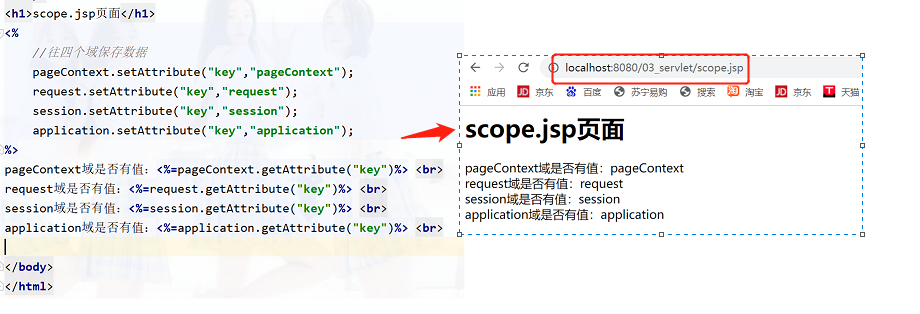
创建另一个jsp页面:

其他范围测试:
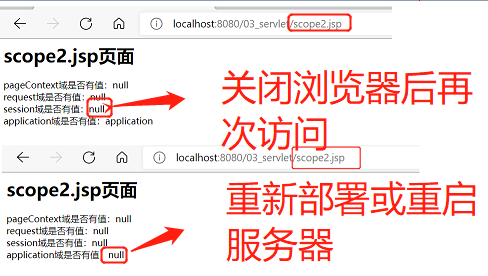
他们的范围是从小到大的,使用时一般先使用小范围,小范围不够用再使用范围。(内存优化的原因)
| 小:pageContext |
| request |
| session |
| 大:application |
jsp中的out输出和response.getWriter输出的区别
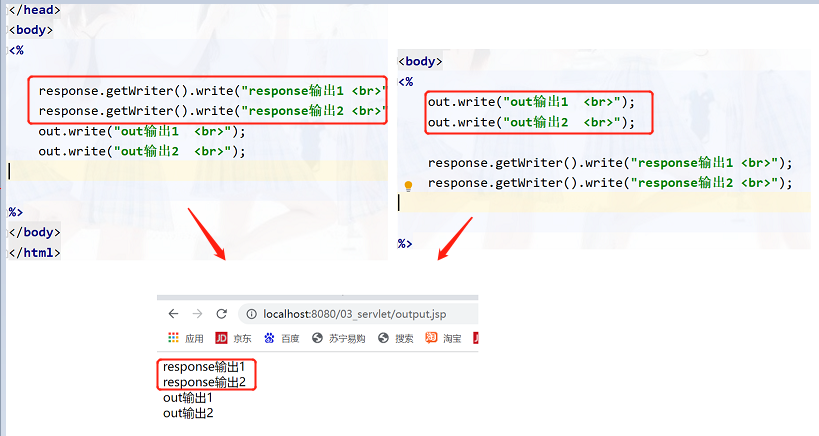
我们可以发现,无论谁在前输出的结果,都是response的在前
图示分析:

当jsp页面中的所有代码执行完之后会做的操作:
1、执行out.flush()操作,会把out缓冲区的数据追加写入到response缓冲区末端。
2、会执行response的刷新操作,会把数据写给客户端。
验证: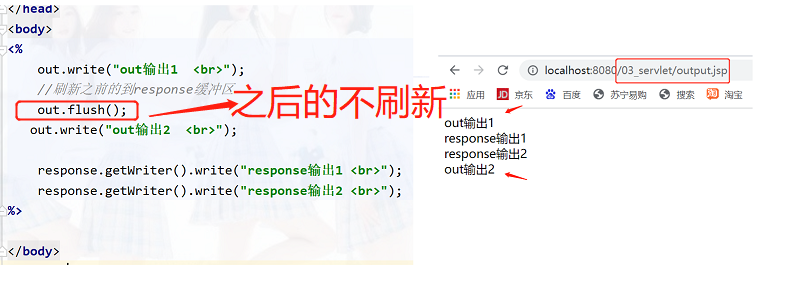
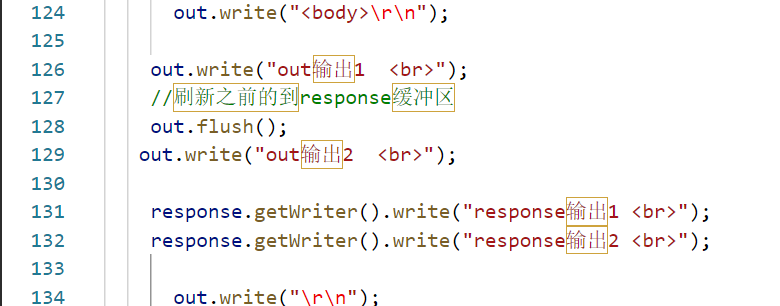
由于jsp翻译之后,底层源代码都是使用out来进行输出,所以一般情况下,我们在jsp页面统一使用out进行输出。避免打乱页面输出的顺序。
out.print()和out.write()
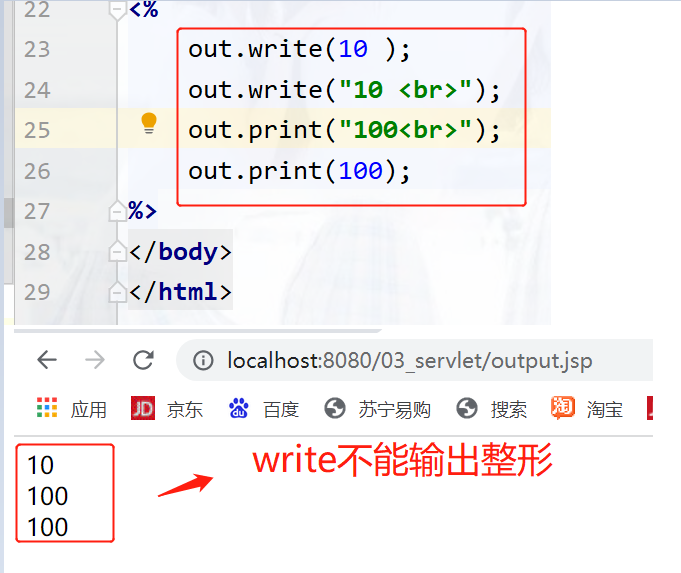
out.write()输出字符串字符串没问题
out.print()可以输出任意数据(都会转化成字符串后调用write输出)
结论:在jsp页面中,可以统一使用呢out.print()来进行输出
jsp常用标签
静态包含
web下创建一个include目录,里面分别写main.jsp和footer.jsp
footer.jsp下
<html>
<head>
<meta charset="utf-8"/>
<title>Insert title here</title>
</head>
<body>
页脚信息
</body>
</html>main.jsp下
</head>
<body>
首页<br>
主体<br>
<%--
include file="" 就是静态包含
file属性指定你要包含的页面路径
地址中的第一个斜杆 / 表示http://ip:port/工程路径/ 映射到idea为web
--%>
<%@include file="/include/footer.jsp" %>
</body>
</html>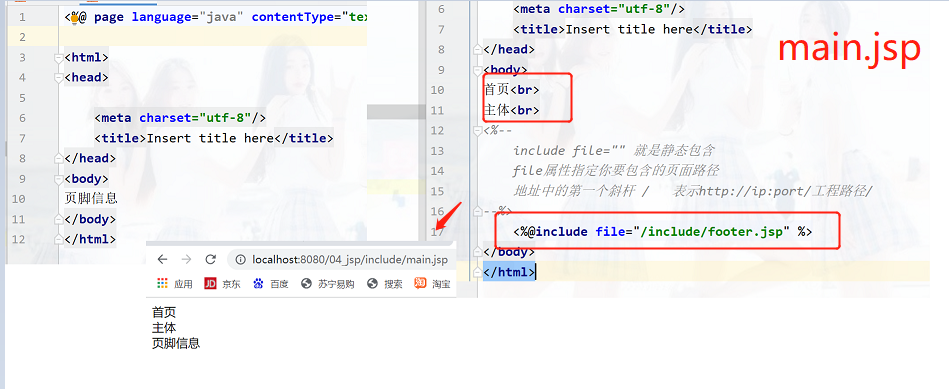
include file=" " 就是静态包含
file属性指定你要包含的页面路径
地址中的第一个斜杆 / 表示http://ip:port/工程路径/ ,映射到idea中为web目录
修改footer.jsp内容
<%@ page language="java" contentType="text/html; charset=utf-8" pageEncoding="utf-8" %>
<html>
<head>
<meta charset="utf-8"/>
<title>Insert title here</title>
</head>
<body>
页脚信息
修改后,主页显示
</body>
</html>
动态包含
格式:
<jsp:include page="/include/footer.jsp"></jsp:include>动态包含也可以和静态包含一样
动态包含的特点:
1、动态包含会把包含的jsp页面也翻译成java代码
2、动态包含底层代码使用如下代码去调用被包含的jsp页面执行输出。
JspRuntimeLibrary.include(request,response,"/include/footer.jsp",out,false);请求转发
格式:
<jsp:forward page=" "></jsp:forward>
<!--page属性设置请求转发的路径-->
jsp练习
练习1
打印九九乘法表
<html>
<head>
</head>
<body >
<h1 >九九乘法表</h1>
<%
for(int i=1;i<10;i++){
for(int j=1;j<=i;j++){
%>
<%=j+"*"+i+"="+(i*j)%>
<%
}
%>
<br/>
<%
}
%>
</body>
</html>
练习2
存储学生信息并打印
pojo包下的student类
package pojo;
public class Student {
private String name;
private int id;
private int age;
public Student(String name, int id, int age) {
this.name = name;
this.id = id;
this.age = age;
}
public Student() {
}
public String getName() {
return name;
}
public void setName(String name) {
this.name = name;
}
public int getId() {
return id;
}
public void setId(int id) {
this.id = id;
}
public int getAge() {
return age;
}
public void setAge(int age) {
this.age = age;
}
@Override
public String toString() {
return "Student{" +
"name='" + name + '\'' +
", id=" + id +
", age=" + age +
'}';
}
}
text1.jsp下
<%@ page import="java.util.List" %>
<%@ page import="pojo.Student" %>
<%@ page import="java.util.ArrayList" %>
<%@ page language="java" contentType="text/html; charset=utf-8" pageEncoding="utf-8" %>
<html>
<head>
<meta charset="utf-8"/>
<title>Insert title here</title>
<%-- 设置样式<style></style>--%>
<style>
table{
border: 1px black solid;
width: 300px;
}
td,tr{
border: 1px black solid;
width: 300px;
}
</style>
</head>
<body>
<%
List<Student> list=new ArrayList<>();
for (int i=1;i<=10;i++){
list.add(new Student("name"+i,i,10+i));
}
%>
<table>
<%for (Student student:list){%>
<%-- tr是一行,td为一列--%>
<tr>
<td><%=student.getName()%></td>
<td><%=student.getId()%></td>
<td><%=student.getAge()%></td>
</tr>
<% } %>
</table>
</body>
</html>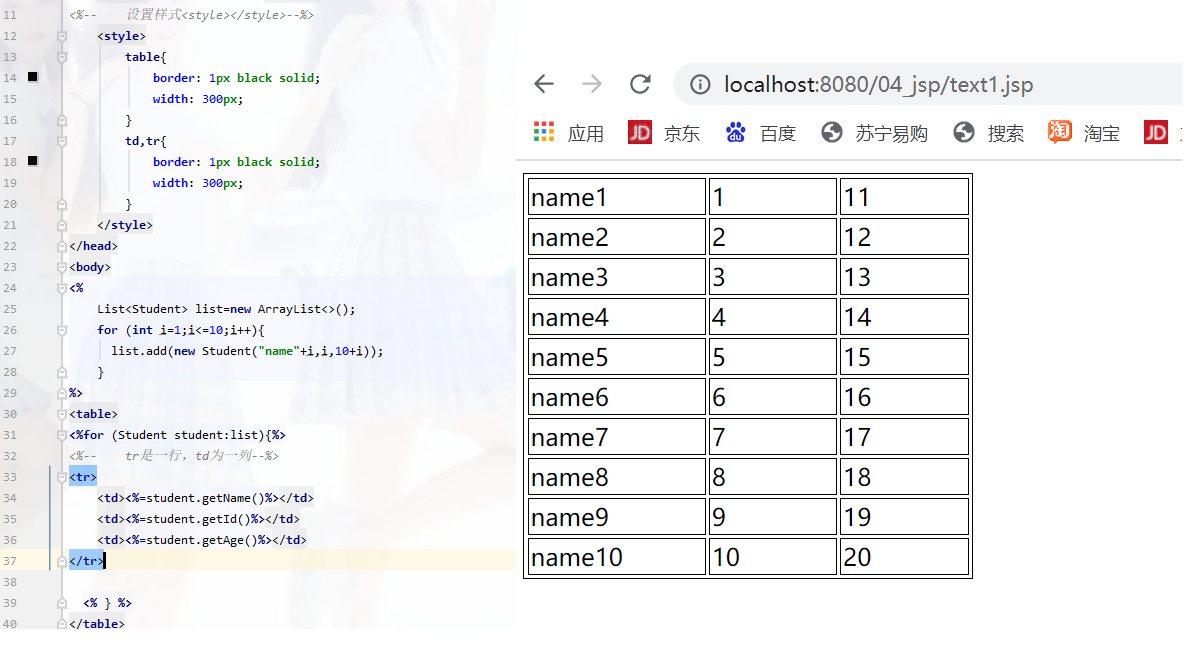
请求转发使用说明
流程图:

SearchStudentServlet类下
package com.Servlet;
import pojo.Student;
import javax.servlet.ServletException;
import javax.servlet.http.HttpServlet;
import javax.servlet.http.HttpServletRequest;
import javax.servlet.http.HttpServletResponse;
import java.io.IOException;
import java.util.ArrayList;
import java.util.List;
public class SearchStudentServlet extends HttpServlet {
@Override
protected void doGet(HttpServletRequest req, HttpServletResponse resp) throws ServletException, IOException {
//获取请求参数
//发sql语句查询学生信息
//使用for循环生成查询到的数据做模拟
List<Student> list=new ArrayList<>();
for (int i=1;i<=10;i++){
list.add(new Student("name"+i,i,10+i));
}
//保存查询到的数据到Request域中
req.setAttribute("stuList", list);
//请求转发到之外的showStudent.jsp中
req.getRequestDispatcher("/showStudent.jsp").forward(req, resp);
}
}
web.xml下:
<servlet>
<servlet-name>SearchStudentServlet</servlet-name>
<servlet-class>com.Servlet.SearchStudentServlet</servlet-class>
</servlet>
<servlet-mapping>
<servlet-name>SearchStudentServlet</servlet-name>
<url-pattern>/searchStudentServlet</url-pattern>
</servlet-mapping>showStudent.jsp下
<%@ page import="java.util.List" %>
<%@ page import="pojo.Student" %>
<%@ page import="java.util.ArrayList" %>
<%@ page language="java" contentType="text/html; charset=utf-8" pageEncoding="utf-8" %>
<html>
<head>
<meta charset="utf-8"/>
<title>Insert title here</title>
<%-- 设置样式<style></style>--%>
<style>
table{
border: 1px black solid;
width: 300px;
}
td,tr{
border: 1px black solid;
width: 300px;
}
</style>
</head>
<body>
<%
List<Student> list= (List<Student>) request.getAttribute("stuList");
%>
<table>
<%for (Student student:list){%>
<%-- tr是一行,td为一列--%>
<tr>
<td><%=student.getName()%></td>
<td><%=student.getId()%></td>
<td><%=student.getAge()%></td>
</tr>
<% } %>
</table>
</body>
</html>运行结果:

Listener监听器
1、Listener监听器他是JavaWeb的三大组件之一。javaweb的三大组件分别是servlet程序、filter过滤器、Listenter监听器。
2、Listenter他是javaEE的规范,规范就是接口
3、监听器的作用是,监听某种事务的变化,然后通过回调函数,反馈给客户或程序去做一些相应的处理。
ServletContextListenter监听器
ServletContextListener他可以监听ServletContext对象的创建和销毁。
ServletContext对象在web工程启动的时候,在web工程停止的时候销毁。
ServletContextListener监听器监听ServletContext对象的步骤
1、编写一个类去实现ServletContextListener
2、实现器两个回调方法
3、到web.xml中去配置监听器
创建类和实线两个方法
package com.Listener;
import javax.servlet.ServletContextEvent;
import javax.servlet.ServletContextListener;
public class MyServletContextListenerImpl implements ServletContextListener {
@Override
public void contextInitialized(ServletContextEvent servletContextEvent) {
System.out.println("Servlet对象被创建了");
}
@Override
public void contextDestroyed(ServletContextEvent servletContextEvent) {
System.out.println("Servlet对象被销毁了");
}
}
web.xml中配置
<listener>
<listener-class>com.Listener.MyServletContextListenerImpl</listener-class>
</listener>